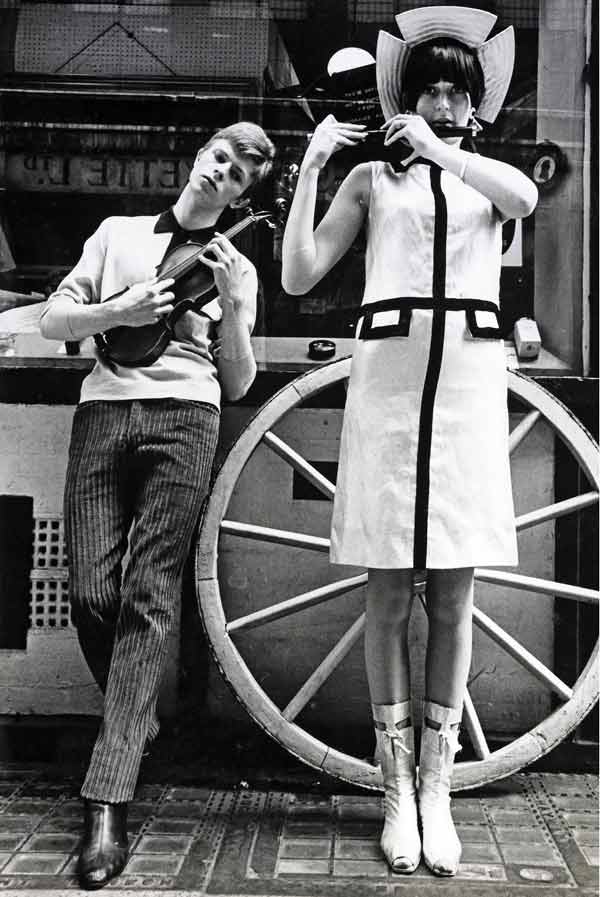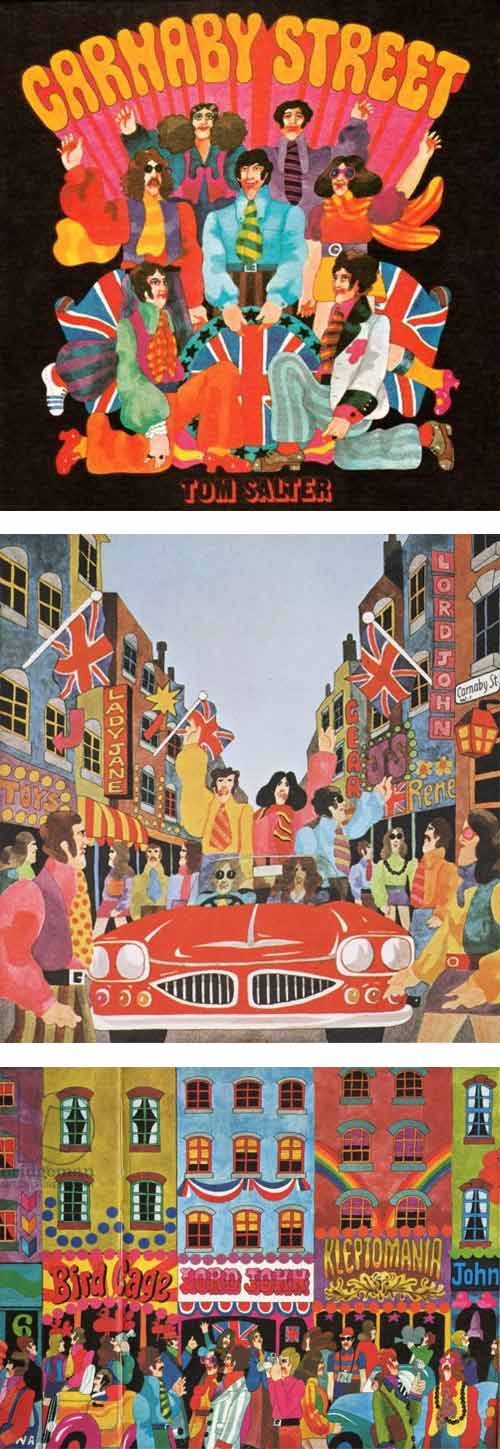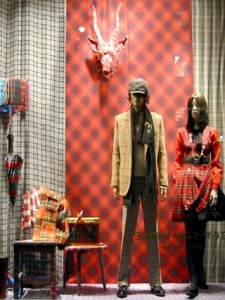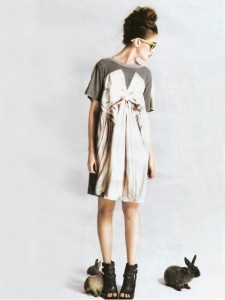Trove
Vintage Fashion for the Modern Girl
Celebrating 50 Years of Carnaby Street Cool
It's less than 200 yards from end to end but for almost a decade its global influence was greater than any other thoroughfare in Britain
November 9, 2013
Carnaby Street was first built in the late 1680s but it will be forever synonymous with the decade when shops such as His Clothes, I Was Lord Kitchener’s Valet and Kleptomania led successive waves of fashion culture from the mods and rockers of the mid-Sixties through the psychedelic hippy era to the Afghan and cheesecloth look of the early Seventies.
Although the street has more than 300 years of history, this year the 140 shops in and around Carnaby Street are marking the 50th anniversary of the start of its extraordinary Sixties heyday with a series of major events.
The celebrations begin on Friday 26 February with the launch of a free “Carnaby Street 1960 to 2010” exhibition at number 38 filled with artefacts ranging from a Sixties paper dress to a rare original copy of the Kinks single Dedicated Follower of Fashion which celebrates the marching “Carnabetian Army”.

Carnaby Street 1967

Kleptomania boutique, Carnaby Street 1966

David Bowie, Carnaby Street 1965, Photo by Fiona Adams
There are also testimonies from key figures such as Who legend Pete Townshend and interviews with ordinary people who lived and worked in the area.
In June there will be a “Summer of Love” music festival in the street, inspired by the sounds that rocked the world almost half a century ago, and in September a fashion show will link the era of the miniskirt with the modern fashion boutiques that line Carnaby Street today.
Curator Amy de la Haye says throughout its history the area has been linked with alternative lifestyles, dating back to the French Huguenots who first settled in the area through to the poet William Blake who was a local resident.
The street, which rapidly declined into a “Kiss me Quick” tourist tat ghetto in the mid-Seventies, is now owned by the property company Shaftesbury Estates, which has tried to revive its reputation by keeping out major chain stores. More than 60 per cent of the shops in the area today are independent.
Carnaby Street and its Soho environs may never again be the global crucible of youth culture that it was in the Sixties but according to Shaftesbury director Simon Quayle “it still provides something you can’t get anywhere else”. Three Carnaby Street veterans remember its heyday.
Philip Townsend, 69
Photographer
Before the Sixties, Carnaby was a dreary, run-down street with just a few little shops. They shut on Saturday afternoon and all day on Sunday. The whole place closed down at 6pm, it was completely different from what it is now.
But Carnaby Street was just meant to happen. People who had never done things like run boutiques before suddenly got liberated and decided to do it. Entrepreneur John Stephens got all this clobber from somewhere—bags and army surplus wear—that was really good and not very expensive and it just took off. I’ve got pictures of Regent Street from the Sixties and there was nobody walking down it. Everyone just automatically went to the right into Carnaby Street and the whole place was jumping.
You were allowed to drive on Carnaby Street and park on it in those days, there were no restrictions. I had a Mini and everyone said, “that’s very trendy”. But if you tooted people to get out of the way, they thought you were a fascist pig so you had to be very careful.
You would always see The Beatles and the Rolling Stones wandering around – the Stones had their offices in Regent Street. But we didn’t have “celebrities” in those days, we just had interesting people, they didn’t have minders and cars following them. You would also see all the models who were always upper-class girls. I was one of the first photographers to get out of the studios and go outside and use real life as a background. The Continental magazines loved it.
There was not a particularly druggy feel to start with, just a bit of pot and some LSD. There really wasn’t a big drug scene until people started making serious money later in the Sixties. However there was no aggravation even then, it was just a very relaxed, happy atmosphere.
It was pure luck that it was in Carnaby Street where it happened, there were lots of streets around there that could have been just as good. None of us knew what we were doing, we just went and did it—there were no rules.
"It was all so terribly stimulating. People would be playing the guitar and smoking a spliff with you and in a few weeks' time they would be playing a concert. One of the guys we hung out with later became Lemmy from Motorhead."

Carnaby Street in the 1960s, Photos by Philip Townsend
Paterson Riley, 63
Retailer
I came from New Zealand in 1964 when I was 19 to see Swinging London only to find it wasn’t swinging for most people. I was working at Harrods as an assistant buyer to start with. The pay was £13 a week and rent was about £6 so by Saturday night most of the money was gone. But then I discovered drugs and women and suddenly Harrods did not seem very exciting.
I ended up doing some painting and decorating in Carnaby Street and one of the shop owners said: “It’s cold up there, why don’t you come in and do some trading, I’ll give you a week’s rent free.” The guy who’d been doing jewellery had just gone bust so I got some jewellery in and a few dope pipes and people started to notice.
One of my first customers was the guy who became Alvin Stardust. I told him to wear all the black jewellery on his dark gloves.
By 10am we’d be playing really loud rock ‘*’ roll music and we were taking so much money we’d have a transit van to clear out the tills twice a day. Pretty soon we had six concessions on Carnaby Street and I was working seven days a week. It was so much fun I didn’t take a holiday for seven years.
The next thing I know I’m getting sherry and cigars from the man at NatWest bank. I was still only 26 or 27—they were such heady times. People were making enough money to buy his and hers Lamborghinis and kidney-shaped swimming pools.
Being a foreigner I mixed with the other foreigners – Persians and Asians and Americans. We didn’t seem to know anyone English. We thought they lived out in the suburbs in places like Bromley.
It was all so terribly stimulating. People would be playing the guitar and smoking a spliff with you and in a few weeks’ time they would be playing a concert. One of the guys we hung out with later became Lemmy from Motorhead.
"It was a time of incredible freedom, anything could happen. I remember one occasion when Tom Jones was walking down Carnaby Street with a cheetah."

Collection of 1960s Mod fashions available on Etsy


Carnaby Street Illustrations by Malcolm English, 1970
Elizabeth Sellar, 68
Boutique owner
We moved to the area in 1964. In those days Carnaby Street had a greengrocers, a grocers and a laundry. But even then you couldn’t believe how buzzing it was. My husband (Irvine) had a menswear shop in Gerrard Street but I remember saying to him: “You’ve got to have a look at this street, you cannot move in it.” He ended up buying the greengrocers, the grocers and the laundry and turned them into Irvine Sellar Menswear. I asked him if I could have the basement of Number 27 for womenswear. We thought of the name Mates because one of my friends worked as Playmates model.
We simply could not get enough stock—you could sell anything. The French loved these mini-kilts and mini-Shetlands we used to sell. You could have stocked them to the ceiling and they would have sold out. I remember people saying “are these belts or skirts?” because they were so short.
We had celebrities coming in all the time but it didn’t phase me at all. It wasn’t like today, back then a real mixture of people of all ages would come in. One day Bette Davis came in and said, “Have you got anything for a size 16?” She just filled a bag full of stuff. Another time Nancy, Lady Astor (the first female MP) came in to buy sweaters. On another day you might see President Johnson’s daughter there chatting with pop stars. That is how it was. You would see the Rolling Stones or the Monkees or the Beach Boys. They would turn up and buy stuff and tell me: “If you watch Top of the Pops tonight I’ll be wearing this shirt.” I remember the Stones’ Brian Jones coming in quite a bit, always completely gone.
The atmosphere was electric, incredible really. My children once asked what it was like but I couldn’t quite explain it—it was just there. We manufactured 80 per cent of our own stock, which we had designed and cut by our own people in the East End and we had our own little factory in Kilburn. Then one day this very handsome 17-year-old boy came in and said: “How would you like to buy some stuff in?” So we ordered five designs from him and had 20 of each in the shop in Carnaby Street and they sold out in half an hour. His name was Richard Caring.
It was a time of incredible freedom, anything could happen. I remember one occasion when Tom Jones was walking down Carnaby Street with a cheetah. It was to publicise a store about to open called Tom Cat. He had just started out at the time.
There were no credit cards then and if people really wanted something but couldn’t afford it they would do anything to secure it. I remember guys leaving valuables like silver flasks and saying: “You keep this for me, I’ll come back with the money.” It was such fun.”





Comments are closed.